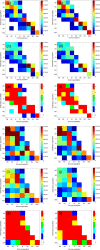Stepping stones to isolation: Impacts of a changing climate on the connectivity of fragmented fish populations
- PMID: 29928304
- PMCID: PMC5999207
- DOI: 10.1111/eva.12613
Stepping stones to isolation: Impacts of a changing climate on the connectivity of fragmented fish populations
Abstract
In the marine environment, understanding the biophysical mechanisms that drive variability in larval dispersal and population connectivity is essential for estimating the potential impacts of climate change on the resilience and genetic structure of populations. Species whose populations are small, isolated and discontinuous in distribution will differ fundamentally in their response and resilience to environmental stress, compared with species that are broadly distributed, abundant and frequently exchange conspecifics. Here, we use an individual-based modelling approach, combined with a population genetics projection model, to consider the impacts of a warming climate on the population connectivity of two contrasting Antarctic fish species, Notothenia rossii and Champsocephalus gunnari. Focussing on the Scotia Sea region, sea surface temperatures are predicted to increase significantly by the end of the 21st century, resulting in reduced planktonic duration and increased egg and larval mortality. With shorter planktonic durations, the results of our study predict reduced dispersal of both species across the Scotia Sea, from Antarctic Peninsula sites to islands in the north and east, and increased dispersal among neighbouring sites, such as around the Antarctic Peninsula. Increased mortality modified the magnitude of population connectivity but had little effect on the overall patterns. Whilst the predicted changes in connectivity had little impact on the projected regional population genetic structure of N. rossii, which remained broadly genetically homogeneous within distances of ~1,500 km, the genetic isolation of C. gunnari populations in the northern Scotia Sea was predicted to increase with rising sea temperatures. Our study highlights the potential for increased isolation of island populations in a warming world, with implications for the resilience of populations and their ability to adapt to ongoing environmental change, a matter of high relevance to fisheries and ecosystem-level management.
Keywords: Champsocephalus gunnari; Notothenia rossii; Scotia Sea; connectivity; individual‐based modelling; ocean warming; population genetics.
Figures







Similar articles
-
Oceanography and life history predict contrasting genetic population structure in two Antarctic fish species.Evol Appl. 2015 Jun;8(5):486-509. doi: 10.1111/eva.12259. Epub 2015 Apr 16. Evol Appl. 2015. PMID: 26029262 Free PMC article.
-
Spatial and temporal operation of the Scotia Sea ecosystem: a review of large-scale links in a krill centred food web.Philos Trans R Soc Lond B Biol Sci. 2007 Jan 29;362(1477):113-48. doi: 10.1098/rstb.2006.1957. Philos Trans R Soc Lond B Biol Sci. 2007. PMID: 17405210 Free PMC article. Review.
-
Population divergences despite long pelagic larval stages: lessons from crocodile icefishes (Channichthyidae).Mol Ecol. 2014 Feb;23(2):284-99. doi: 10.1111/mec.12612. Epub 2013 Dec 28. Mol Ecol. 2014. PMID: 24372945
-
Comparison of Fatty Acid Contents and MMP-1 Inhibitory Effects of the Two Antarctic Fish, Notothenia rossii and Champsocephalus gunnari.Molecules. 2022 Jul 17;27(14):4554. doi: 10.3390/molecules27144554. Molecules. 2022. PMID: 35889426 Free PMC article.
-
The Minderoo-Monaco Commission on Plastics and Human Health.Ann Glob Health. 2023 Mar 21;89(1):23. doi: 10.5334/aogh.4056. eCollection 2023. Ann Glob Health. 2023. PMID: 36969097 Free PMC article. Review.
Cited by
-
Climatic change drives dynamic source-sink relationships in marine species with high dispersal potential.Ecol Evol. 2021 Feb 16;11(6):2535-2550. doi: 10.1002/ece3.7204. eCollection 2021 Mar. Ecol Evol. 2021. PMID: 33767820 Free PMC article.
-
Along-shelf connectivity and circumpolar gene flow in Antarctic silverfish (Pleuragramma antarctica).Sci Rep. 2018 Dec 14;8(1):17856. doi: 10.1038/s41598-018-36030-x. Sci Rep. 2018. PMID: 30552350 Free PMC article.
-
Trans-Atlantic Distribution and Introgression as Inferred from Single Nucleotide Polymorphism: Mussels Mytilus and Environmental Factors.Genes (Basel). 2020 May 10;11(5):530. doi: 10.3390/genes11050530. Genes (Basel). 2020. PMID: 32397617 Free PMC article.
-
Twenty-First-Century Environmental Change Decreases Habitat Overlap of Antarctic Toothfish (Dissostichus mawsoni) and Its Prey.Glob Chang Biol. 2025 Feb;31(2):e70063. doi: 10.1111/gcb.70063. Glob Chang Biol. 2025. PMID: 39930895 Free PMC article.
-
Individual-based eco-evolutionary models for understanding adaptation in changing seas.Proc Biol Sci. 2021 Nov 10;288(1962):20212006. doi: 10.1098/rspb.2021.2006. Epub 2021 Nov 10. Proc Biol Sci. 2021. PMID: 34753353 Free PMC article. Review.
References
-
- Ainley, D. G. , & Blight, L. K. (2009). Ecological repercussions of historical fish extraction from the Southern Ocean. Fish and Fisheries, 10(1), 13–38. https://doi.org/10.1111/j.1467-2979.2008.00293.x - DOI
-
- Andrello, M. , Mouillot, D. , Somot, S. , Thuiller, W. , & Manel, S. (2015). Additive effects of climate change on connectivity between marine protected areas and larval supply to fished areas. Diversity and Distributions, 21(2), 139–150. https://doi.org/10.1111/ddi.12250 - DOI
-
- Barrera‐Oro, E. R. , & Casaux, R. J. (1992). Age estimation for juvenile Notothenia rossii from Potter Cove, South Shetland Islands. Antarctic Science, 4(2), 131–136.
-
- Barrera‐Oro, E. , Marschoff, E. , & Ainley, D. (2017). Changing status of three notothenioid fish at the South Shetland Islands (1983–2016) after impacts of the 1970–80s commercial fishery. Polar Biology, 40(10), 2047–2054. https://doi.org/10.1007/s00300-017-2125-0 - DOI
-
- Beers, J. M. , & Sidell, B. D. (2011). Thermal tolerance of Antarctic notothenioid fishes correlates with level of circulating hemoglobin. Physiological and Biochemical Zoology, 84(4), 353–362. https://doi.org/10.1086/660191 - DOI - PubMed
LinkOut - more resources
Full Text Sources
Other Literature Sources

